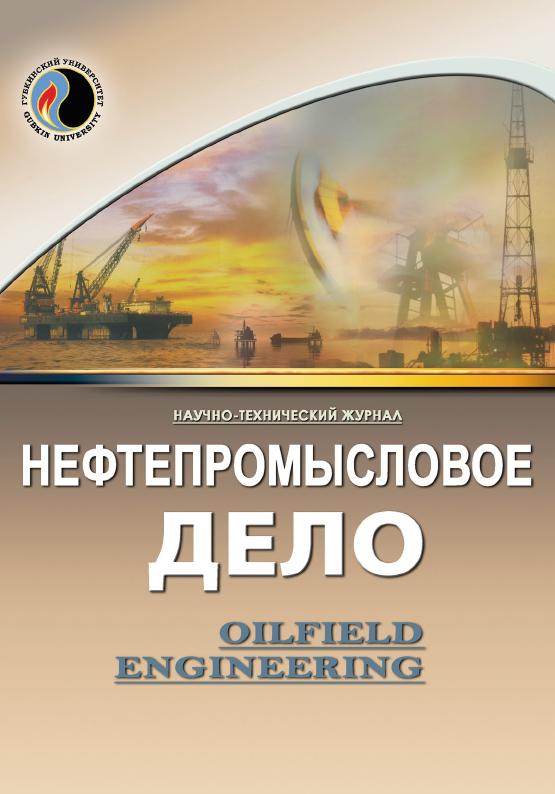Scientific and technical journal
«Oilfield engineering»
ISSN 0207-2351

CRM-model for the analysis of water encroachment of a group of wells during waterflooding, taking into account the mutual influence of producing wells
UDC: 622.276.43
DOI: 10.33285/0207-2351-2023-9(657)-22-29
Authors:
1 Federal State Institution "Scientific Research Institute for System Analysis of the Russian Academy of Sciences", Moscow, Russia
Keywords: CRM-model, well interference, waterflood analysis, reservoir pressure maintenance system analysis, producing wells interference
Annotation:
A capacitance resistive model (CRM-model) is a mathematical model that describes wells interference in a reservoir using two types of equations: the fluid volume conservation equation, which is responsible for "capacitance" (C), and the well inflow equation, which is responsible for resistance (R). The article proposes a numerical CRM-model to analyze water-flooding of a group of wells during water-flooding, taking into account the mutual influence of producing wells. When calculating pressure, the interference of production and injection wells, changes in saturation and productivity coefficient over time are taken into account. Water-cut is calculated through water saturation. When calculating water saturation, the effect of injection wells and the compressibility of the reservoir and water are taken into account. Reservoir pressure is excluded from the model using the inflow equation. An oil field in the Western Siberia is taken as a field example. It is shown that consideration of producing wells mutual influence and productivity coefficient change over time improves the quality of the model. Consideration of compressibility when calculating water saturation allows replicating the actual fluctuations of well water cut in the model.
Bibliography:
1. Dan’ko M.Yu., Brilliant L.S., Zav’yalov A.S. Primenenie metoda dinamicheskogo material’nogo balansa i CRM-metoda (capacitance-resistive model) k podschetu zapasov achimovskikh i bazhenovskikh kollektorov // Nedropol’zovanie XXI vek. – 2019. – № 4(50). – S. 76–85.
2. Issledovanie osobennostey otsenki vzaimovliyaniya skvazhin na primere modeli CRM / A.A. Ruchkin, S.V. Stepanov, A.V. Knyazev [i dr.] // Vestn. Tyumenskogo gosudarstvennogo un-ta. Fiz.-mat. modelirovanie. Neft’, gaz, energetika. – 2018. – T. 4, № 4. – S. 148–168. – URL: DOI: https://doi.org/10.21684/2411-7978-2018-4-4-148-168
3. Khatmullin I.F., Andrianova A.M., Margarit A.S. Poluanaliticheskie modeli rascheta interferentsii skvazhin na baze klassa modeley CRM // Neft. khoz-vo. – 2018. – № 12. – S. 38–41. – DOI: 10.24887/0028-2448-2018-12-38-41
4. Application of CRM for Production and Remaining Oil Reserves Reservoir Allocation In Mature West Siberian Waterflood Field / A. Gladkov, R. Sakhibgareev, D. Salimov [et al.] // Paper presented at the SPE Russian Petroleum Technology Conference, Moscow, Russia, October 2017. – DOI: URL: https://doi.org/10.2118/187841-MS
5. Prediction of Immiscible Gas Flooding Performance: a Modified Capacitance–Resistance Model and Sensitivity Analysis / S.H. Yousefi, F. Rashidi, M. Sharifi [et al.] // Pet. Sci. – 2019. – Vol. 16. – P. 1086–1104. – DOI: URL: https://doi.org/10.1007/s12182-019-0342-6
6. Lasdon L., Shirzadi S., Ziegel E. Implementing CRM models for improved oil recovery in large oil fields // Optimization and Engineering. – 2017. – Vol. 18. – P. 87–103. – DOI: URL: https://doi.org/10.1007/s11081-017-9351-8
7. A State-of-the-Art Literature Review on Capacitance Resistance Models for Reservoir Characterization and Performance Forecasting / R.W. Holanda, E. Gildin, J.L. Jensen [et al.] // Energies. – 2018. – Vol. 11. – P. 3368. – DOI: URL: https://doi.org/10.3390/en11123368
8. Sayarpour M. Development and Application of Capacitance-Resistive Models to Water/CO2 Floods: Dis. Ph.D. Presented to the Faculty of the Graduate School of The University of Texas at Austin in Partial Fulfillment of the Requirements for the Degree of Doctor of Philosophy. – 2008. – 236 p. – DOI: URL: https://doi.org/10.13140/RG.2.1.1798.3847
9. Stepanov S.V., Pospelova T.A. Novaya kontseptsiya matematicheskogo modelirovaniya dlya prinyatiya resheniy po razrabotke mestorozhdeniy // Neft. khoz-vo. – 2019. – № 04.– S. 50–53. – DOI: 10.24887/0028-2448-2019-4-50-53
10. Olenchikov D., Posvyanskii D. Application of CRM-Like Models for Express Forecasting and Optimizing Field Development // SPE-196893-MS. This paper was prepared for presentation at the SPE Russian Petroleum Technology Conference held in Moscow, Russia, 22–24 October 2019.
11. Sayarpour M., Kabir C.S., Lake L.W. Field Applications of Capacitance Resistive Models in Waterfloods // SPE Annual Technical Conference and Exhibition. – 2008. – DOI: 10.2118/114983-MS
12. The use of capacitance-resistance models for rapid estimation of waterflood performance and optimization / M. Sayarpour, E. Zuluaga, C.S. Kabir, L.W. Lake // J. of Pet. Sci. and Eng. – 2009. – Vol. 69, Issues 3–4. – P. 227–238. – DOI: URL: https://doi.org/10.1016/j.petrol.2009.09.006
13. Probabilistic History Matching With the Capacitance-Resistance Model in Waterfloods: A Precursor to Numerical Modeling / M. Sayarpour, C.S. Kabir, K. Sepehrnoori, L.W. Lake // Paper presented at the SPE Improved Oil Recovery Symposium, Tulsa, Oklahoma, USA, April 2010. – DOI: URL: https://doi.org/10.2118/129604-MS
14. Basniev K.S., Kochina I.N., Maksimov V.M. Podzemnaya gidrodinamika. – M.: Nedra, 1993. – 416 s.